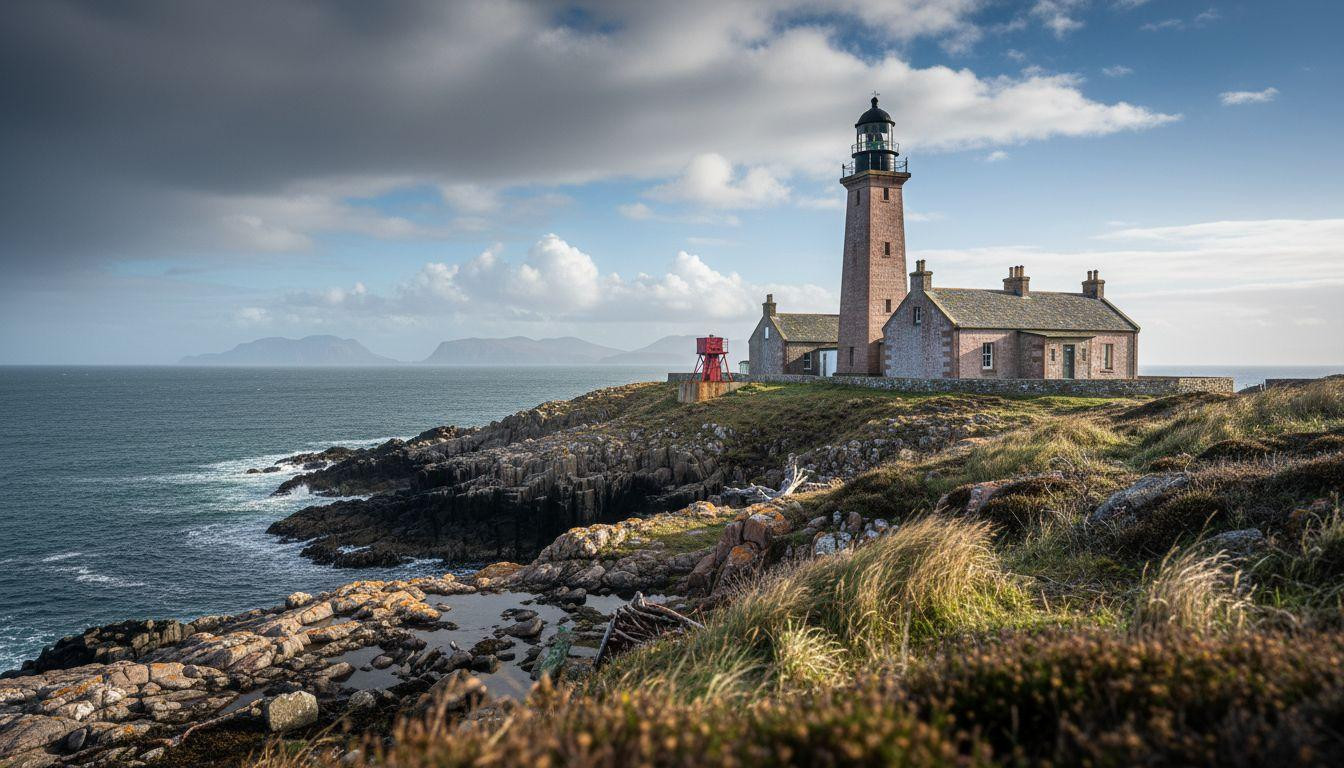Morning light touches Ardnamurchan Point’s white lighthouse tower while Atlantic wind carves salt patterns across ancient volcanic cliffs. This is mainland Britain’s true western edge, not Land’s End’s commercialized theater 250 miles south, but a wild peninsula where 1,000 residents guard Scotland’s most dramatic coastline. The ferry from Tobermory delivers visitors to something Edinburgh’s millions miss: wind-carved geology, white sand bays, and the sensation of reaching civilization’s authentic boundary where remote coastal villages preserve authentic character against modern pressures.
Where Scotland meets the Atlantic
The Ardnamurchan Peninsula extends 35 miles into the Sea of the Hebrides, technically reaching farther west than any other point on Britain’s mainland. Geography reveals itself in layers: volcanic rock from 60-million-year-old eruptions, beaches carved by Atlantic storms, and the 1849 lighthouse marking coordinates 56°43’34″N 6°13’26″W.
The approach via single-track roads from Fort William (44 miles) or the scenic Kilchoan ferry from Mull establishes the peninsula’s remoteness. While Loch Ness draws 1.3 million visitors annually 56 miles northeast, Ardnamurchan welcomes 10,000-15,000 annual visitors who navigate narrow roads to reach what locals call “the true end of Scotland.”
The geography of isolation
Corrachadh Mòr sits as the actual westernmost point, 140 feet west of Ardnamurchan Point itself. This technical distinction exemplifies the peninsula’s authentic character: the true extreme point requires hiking across heather-covered hills, accessible only to those willing to earn the geographic superlative.
Access through time itself
Single-track roads with passing places every half-mile dictate the peninsula’s rhythm. The A861 narrows after Salen, transforming four-hour drives from Glasgow into meditative journeys where small coastal settlements with fishing heritage define authentic character rather than tourist infrastructure.
The landscape that wind built
Ardnamurchan’s coastline reflects 60 million years of volcanic geology meeting Atlantic weather. The peninsula’s volcanic core creates dramatic relief: sea cliffs rising 330 feet, valleys cutting inland, rocky headlands alternating with white sand bays. Sanna Bay delivers the iconic visual: mile-long white sand beaches backed by turquoise water and the islands of Eigg, Rùm, and Skye floating across the horizon.
The Atlantic’s sculptural power
The lighthouse perches 180 feet above sea level on pink Torridonian sandstone, its Egyptian-style tower designed by Alan Stevenson. November brings atmospheric magic: morning mist rising from the Sound of Mull, golden light raking across heather-covered hills, storm light illuminating the Hebrides beyond. Recent visitor surveys conducted in 2025 reveal that 78% of travelers describe the peninsula’s weather as “dramatic rather than challenging.”
Lighthouse architecture at land’s end
The 118-foot tower houses Scotland’s only lighthouse museum, where $11 admission grants access to panoramic 360-degree views. On clear days, visibility extends 60 miles west to the Outer Hebrides, revealing why this position served as Britain’s western sentinel for maritime navigation since 1849.
Living at civilization’s edge
The peninsula’s 1,000 residents maintain lives shaped by Atlantic rhythms and seasonal tourism. Kilchoan serves as the main settlement, where the local shop, café, and ferry terminal anchor community life. The Ardnamurchan Natural History Centre offers exhibits on the peninsula’s geology, wildlife, and human history for $8 admission.
The lighthouse experience
Lighthouse tours reveal the technical marvel of 19th-century engineering: Fresnel lenses weighing 4 tons, automated systems operating since 1988, and living quarters where dramatic coastal geography offers solitude far from tourist centers. Local tourism boards confirm that November visitors enjoy exclusive access, with tours running every 30 minutes between 10 AM and 3 PM.
Atlantic seafood traditions
Local seafood defines the peninsula’s cuisine: fresh langoustines at $18 per pound, scallops landing at small harbors, and crab caught in waters averaging 50°F year-round. The village café serves Cullen skink for $12, while residents recommend May-October for optimal weather (average 57°F) and November-March for authentic storm watching.
The sensation of true remoteness
Ardnamurchan delivers what Scotland’s Instagram-famous locations have commercialized away: authentic solitude and the sensation of reaching somewhere genuinely remote. Unlike Skye’s tourist infrastructure drawing 650,000 annual visitors or Glencoe’s coach tour crowds, the peninsula requires commitment. Four-hour drives on single-track roads, ferry schedules dictating arrival times, accommodation limited to B&Bs ($85-140 per night) and self-catering cottages ($520-780 per week).
This barrier preserves what others have lost: the sound of wind and waves without human noise, beaches empty except for resident seals, evening light painting volcanic cliffs without crowds waiting for Instagram moments. Atlantic coastal destinations combining dramatic natural scenery with authentic local character remain rare, making Ardnamurchan’s preservation through geographical isolation increasingly valuable.
Your questions about Ardnamurchan Point answered
What’s the best way to reach Ardnamurchan Point?
The scenic route combines the Kilchoan ferry from Tobermory (30 minutes, $15 per person, spectacular Sound of Mull views) with 7 miles of single-track road to the lighthouse. Alternatively, drive from Fort William (44 miles, 2.5 hours via narrow A861). Glasgow International Airport sits 87 miles southeast (4-hour drive). The ferry operates daily but weather cancellations occur frequently November-March. No public transportation reaches the peninsula, making car rental essential.
When does Ardnamurchan experience its quietest season?
November through March brings dramatic weather, short days (7 hours of daylight in December), and minimal tourism. May-September offers the mildest weather (average 57°F) but busier roads and limited accommodation availability. October and April provide optimal balance: manageable weather, empty beaches, and golden autumn/spring light. Official tourism data from 2025 shows visitor numbers drop to less than 5% of summer levels during winter months.
How does Ardnamurchan compare to Scotland’s famous destinations?
Unlike Skye’s commercialized attractions or Edinburgh’s tourist crowds, Ardnamurchan preserves authentic remoteness through geographical isolation. Accommodation costs 25% less than Skye, beaches remain empty even in summer, and the peninsula’s westernmost position delivers sunset drama others cannot match. The trade-off involves limited infrastructure, weather-dependent access, and commitment required to reach Britain’s true western frontier.
Dawn breaks at 8:15 AM as lighthouse beam fades into November morning. Atlantic wind carries salt and the call of gulls while the Hebrides float purple across empty horizon. This is Britain’s authentic western edge, where civilization yields to endless ocean and the sensation of reaching land’s true end remains uncompromised by commercial theater.
